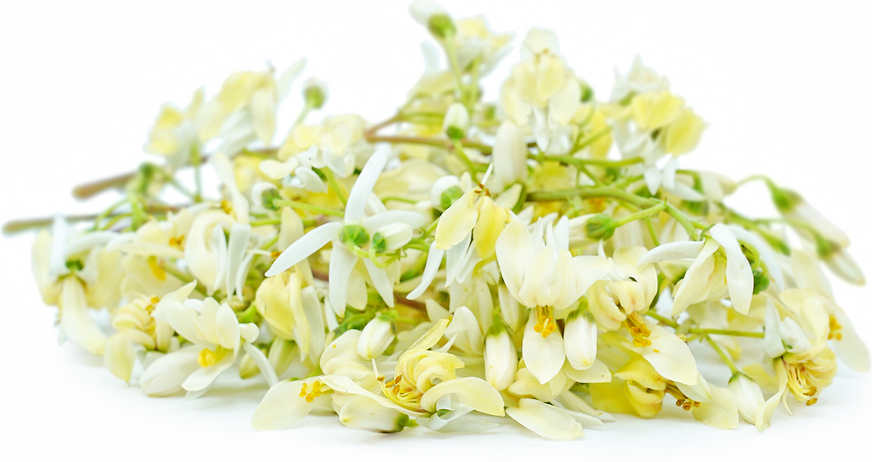


Moringa Flowers
Estimated Inventory, bskt : 0
Description/Taste
Moringa flowers are small, averaging two centimeters in diameter, and are found hanging in delicate clusters from the branches of the moringa tree. Each flower contains five soft, thin, and white petals that are sometimes flushed with yellow and have a drooping quality, growing in multiple directions. The petals also surround slender stamens with bright yellow pollen attached to the anthers. Moringa flowers are aromatic with a fresh, green scent and have a mild, subtly sweet flavor. The younger flowers are known to have the best texture and taste, and when cooked, they develop a flavor that is reminiscent of a combination between asparagus and mushrooms.
Seasons/Availability
Moringa flowers are available year-round in tropical climates. In colder, semiarid to subtropical regions, the trees may only flower once in the spring through early summer.
Current Facts
Moringa flowers, botanically classified as Moringa oleifera, are fragrant, edible blooms found on a fast-growing, wispy tree belonging to the Moringaceae family. The moringa tree is an ancient, medicinal plant native to Asia that is used for its healing abilities, often called the “miracle tree.” All parts of the tree are used, including the roots, fruits, flowers, and leaves, and while the main elements of the tree are relatively common, the small, white flowers are considered a delicacy. Moringa flowers may be found year-round in some tropical locations or found seasonally in subtropical to semiarid regions. The flowers are traditionally picked when young, and once harvested, they are incorporated fresh or cooked into a wide variety of culinary applications. In the modern-day, moringa trees are also being extensively planted and studied as a source of nutrition for regions of the world struggling with poverty, malnutrition, and hunger.
Nutritional Value
Moringa flowers are a good source of vitamin A, a nutrient that can help boost the immune system and protect overall vision health. The flowers also contain calcium to strengthen bones, vitamin C to reduce inflammation, and some potassium, iron, and amino acids. In traditional medicines worldwide, especially in Ayurveda, Moringa flowers are steeped into teas and used in tonics to reduce symptoms associated with colds and cleanse the body.
Applications
Moringa flowers are best suited for both raw and lightly cooked applications such as frying or simmering. The flowers must be soaked in water before consumption as many insects are attracted to the flowers and may still be inside the petals when harvested. The stamen and pistils should also be removed before eating. Once cleaned, the petals can be sprinkled into salads, blended into smoothies or juices, or pressed into oils. Moringa flowers can also be stir-fried into rice and noodle dishes, used as a garnish for curries, soups, and stews, fried and eaten as a snack, or incorporated into omelets, pasta, pizza, and seafood dishes. In India, Moringa flowers are frequently stir-fried into thoran, a side dish blending chile peppers, spices, and onions into a paste and using it to flavor the flowers. Besides fresh applications, Moringa flowers can be dried and steeped in hot water to make a nutritional tea. Moringa flowers pair well with spices such as garam masala, turmeric, curry powder, and cumin, aromatics such as ginger, garlic, and shallots, coconut, bell pepper, green beans, and meats such as mutton, poultry, and fish. Moringa flowers should be used immediately for the best quality and flavor and will keep for a couple of days when stored in an airtight container in the refrigerator. Dried Moringa flowers will keep up to one year when stored in an airtight container in a dark location.
Ethnic/Cultural Info
In the 2018 Hawaii Food and Wine Festival, moringa was the featured ingredient in the Crops & Hops cooking competition, a culinary event promoting emerging crops grown in Hawaii. Crops & Hops was just one of many events that occurred throughout the islands during the three-day festival, and the cooking competition was judged by festival creators Alan Wong and Roy Yamaguchi. Seventeen chefs throughout the United States participated in the competition, showcasing their best moringa-infused dishes, and three chefs were selected to compete in the finals on Oahu. During the competition, moringa flowers and leaves were incorporated into teas, pasta, a chicken-papaya soup, and the leaves were ground into a powder for use as a coating on fried shrimp. In Waipahu, Oahu, the annual Malunggay Festival also incorporates all parts of the moringa tree, including the leaves, flowers, and fruits, into traditional Filipino cuisine. The festival is held to honor the nutritious plant and unite the local Filipino community. Malunggay is the Filipino name for moringa, and the festival centers around promoting organic farmers while connecting them to consumers and chefs. During the festival, parts of the moringa tree were cooked into quiches, chicken soups, and salads.
Geography/History
Moringa is native to India and has been growing wild since ancient times. The first recorded uses of the tree were mentioned in medicinal texts over 5,000 years ago, and it is believed that the leaves were also spread along trade routes into Europe and Northern Africa sometime during the Egyptian and Roman Empires. Today moringa has spread throughout tropical to subtropical regions around the world and can be found in Asia, Southeast Asia, Oceania, Australia, Africa, Central and South America, the Caribbean, and in Hawaii, Mexico, and Florida of North America. Moringa flowers are primarily foraged from the wild, or they can be found seasonally through local farmer’s markets.
Recipe Ideas
Recipes that include Moringa Flowers. One
| Bawarchi |
|
Moringa Flower Chutney |
| I Camp In My Kitchen |
|
Moringa Flower Dal |
| Food 52 |
|
Moringa Flower Thoran |
| My Cooking Canvas |
|
Moringa Flower Fritters |




